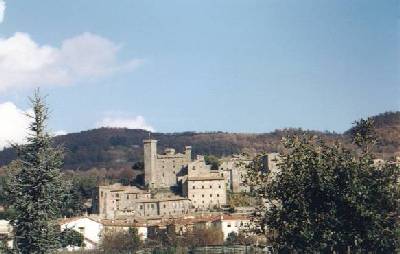Bolsena
is a charming town near Viterbo, stretching on the eastern
shores of the homonymous lake. Situated on the Volsinii
hills and straddling the Via Cassia, only 100 km away from
Rome, this historic town is noted for its picturesque look
and the natural beauty of its landscapes. Visitors can
expect a warm hospitality from people who still live in
the spirit of old, genuine traditions. Its origins can be
traced back to the 3rd century B.C., when Velzna, one of
the most important Etruscan towns, was destroyed and then
founded again as Volsinii (today's Bolsena).
In the 4th century the Roman town was abandoned, probably
after Longobard raids. Then, the population settled on the
very crag where a quaint medieval quarter now lies,
clustering around an imposing Castle. In 1398 Pope
Boniface IX put the town under the control of the
Monaldeschi della Cervara, but in 1451 it returned to the
Church. During the Renaissance, it became one of the
favourite destinations of famous Popes such as Leo X,
Pious II and Paul III.
|
 |
Bolsena
features a good number of ancient ruins, such as the
ones of the town walls, old worship sites and the
Mercatello amphitheatre, representing the northern
boundary of the old Volsinii. The archaeological
excavations brought to light the Roman forum
surrounded by workshops, a church and patrician
houses where incredible frescos and mosaic floors
can be admired. On the surrounding hills, it is
possible to visit a number of necropolis with
different types of Etruscan tombs: "a
camera" (chamber tomb) and "a fossa"
(pit tomb) probably dating back to the period
between the 3rd century B.C. and the 4th century
A.C.
The awe-inspiring Monaldeschi Castle (12th-14th
centuries), and all the other fortifications along
the lines of communication, are living evidence of
the Middle Ages culture and glory. Originally built
as a Longobard strong point, it was acquired and
beautifully renovated during the Monaldeschi's rule.
Today, it is home to the "Museo
Territoriale" of Bolsena showing interesting
archaeological finds and where one can learn the
story of the lake and the peoples who settled the
area. |
|
The
most famous monument of Bolsena is the
"Collegiata" church of Santa Cristina, the shape
of which resulted from the work of transformation wanted
by Cardinal Giovanni de' Medici at the end of the 15th
century. The construction of four different churches in
three different periods resulted in the present structure
of the Collegiata, the oldest part being an ancient
Oratory built around the tomb of Santa Cristina, dug out
of a rock. In this very place the miracle of the Corpus
Domini took place. Pope Urban IV instituted the Corpus
Christi Day, that is still celebrated with a solemn
procession through the streets paved with flowers and
visited by tourists and pilgrims. The feast of Santa
Cristina, martyr and patron saint of Bolsena, is equally
important. Every year, on the 23rd and 24th of July, the
sufferings of the Saint (the MISTERI) are celebrated by
staged representations taking place in the main squares of
the town. Other important attractions include the
Renaissance "Palazzo del Drago", the church of
St. Francis and the Sanctuary of the Madonna del Giglio
(16th century).
The lake of Bolsena, with its clear and unpolluted waters,
is the largest volcanic lake in Europe and fishing is the
main local business, thanks to the wealth of fish species
living in it.
The "coregone" is the most typical fish of the
lake and Dante, writes in The Divine Comedy about Pope
Martin IV greed for eating eels soaked in
"vernaccia" wine.
Grapes, olives, potatoes, vegetables and forage are the
main products of the town, and the surrounding area is
entirely tree-covered.
Tourism is the most important activity and the town which
offers well-structured accommodation facilities. Bolsena
is one of the most popular tourist destinations of the
Upper "Tuscia". |

